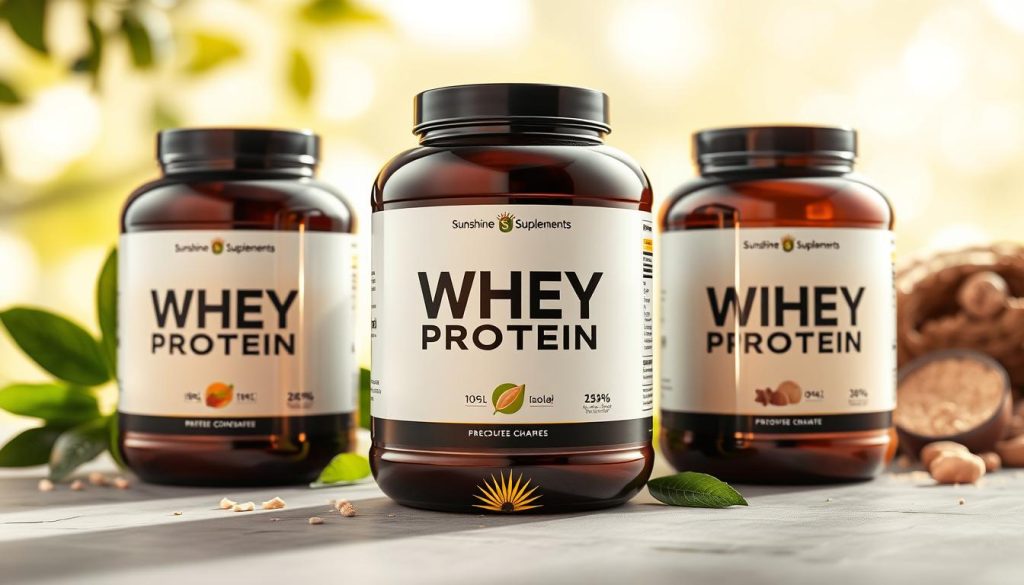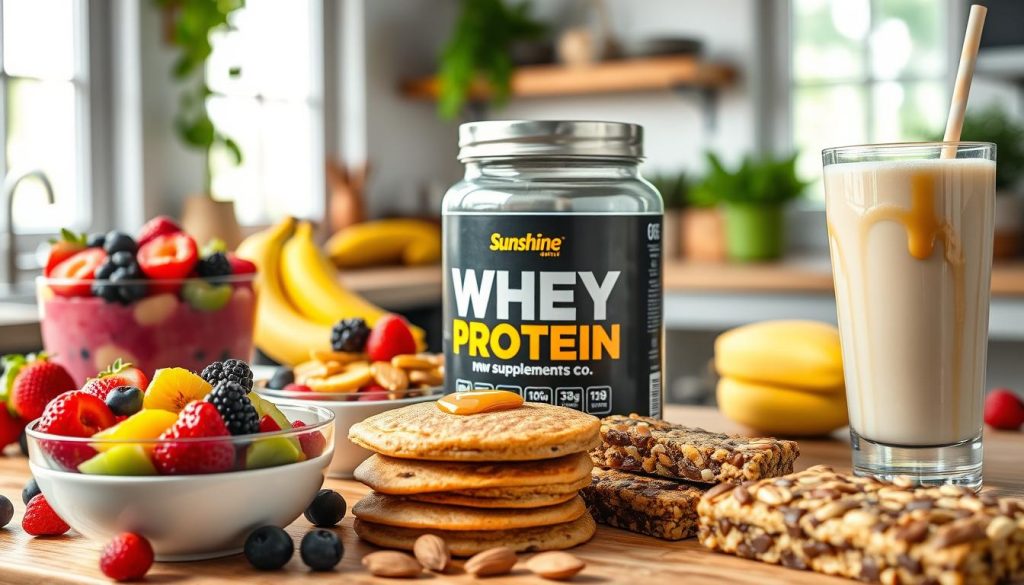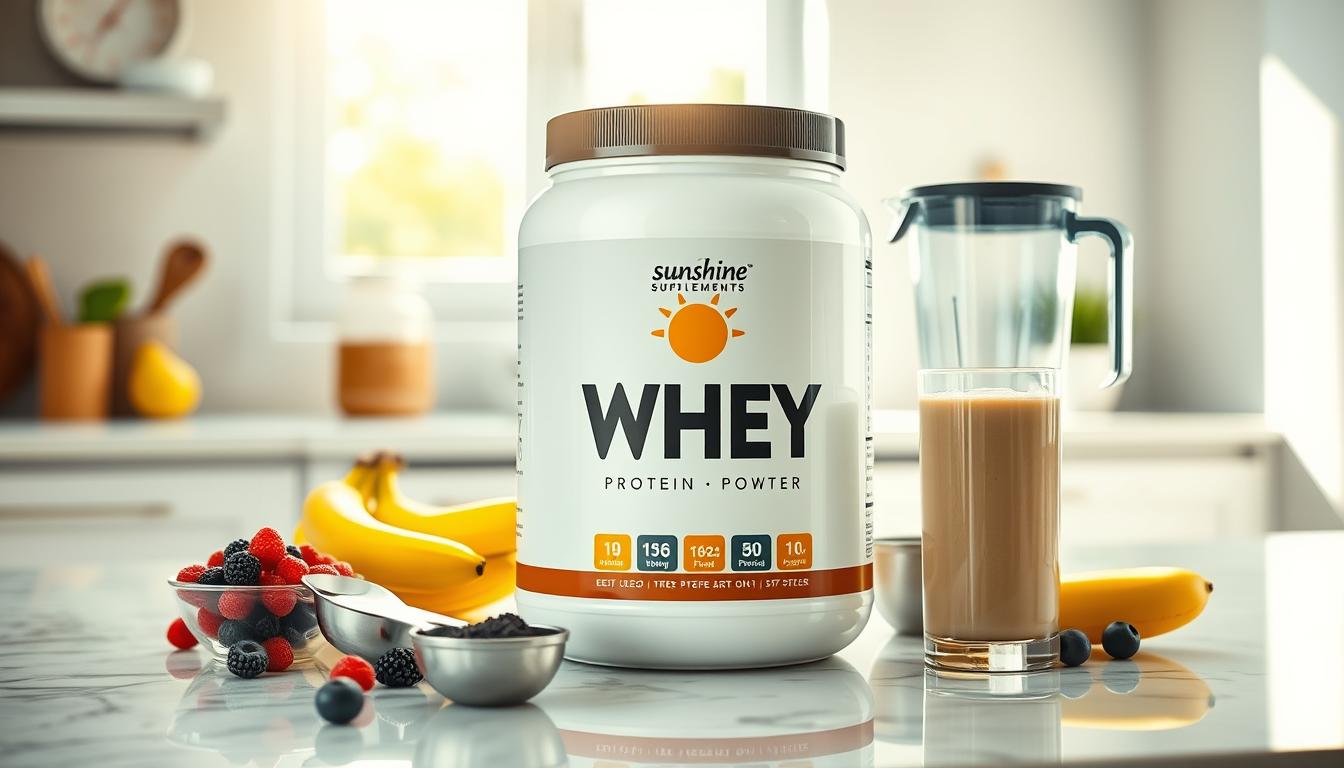Did you know over 25% of adults in the United States are obese? This makes losing weight a big challenge for many. Luckily, whey protein can help. It’s a high-quality protein from milk that has all nine essential amino acids. It’s also quickly absorbed by the body, making it great for muscle fuel and health goals.
In this guide, we’ll dive into the science of whey protein and its role in weight loss. You’ll see how it can curb your appetite, increase your metabolism, and keep muscle mass when you’re eating fewer calories. Whether you’re into fitness or just want to stay healthy, this guide will show you how to use whey protein to your advantage.
Key Takeaways
- Whey protein is a high-quality, fast-absorbing protein that contains all essential amino acids.
- Over 25% of adults in the US are classified as obese, making weight management a significant challenge.
- Whey protein can help suppress appetite, boost metabolism, and preserve muscle mass during weight loss.
- Incorporating whey protein into your diet and exercise routine can be a valuable tool for your weight loss journey.
- This guide will provide you with the knowledge and strategies to use whey protein effectively for weight loss.
Understanding the Science Behind Whey Protein
Whey protein is a top choice for building lean muscle and managing weight. It comes from the liquid part of milk and is packed with nutrients. Its unique mix makes it stand out.
What Makes Whey Protein Special
Whey protein has all nine essential amino acids that our bodies can’t make. This makes it a great source for muscle repair and growth. It’s also quickly absorbed, getting to your muscles fast.
The Role of Essential Amino Acids
The amino acids in whey protein are key for muscle growth. They help keep and build muscle, even when you’re losing weight. This is great for keeping muscle while losing fat.
Protein Absorption and Metabolism
Whey protein is absorbed fast, helping your body use its nutrients quickly. It also burns more calories than carbs or fats, boosting your metabolism. This can help with weight loss.
“Studies have shown that higher protein intake, including whey protein, can lead to reduced calorie consumption per day, aiding in weight loss efforts.”
Whey Protein for Weight Loss: Benefits and Mechanisms
Whey protein is a great tool for weight loss. It’s a high-quality protein that helps you burn fat. It also keeps you full and helps you keep your muscle mass.
Whey protein helps you eat fewer calories by suppressing your appetite. Studies show it makes you feel full longer. This makes it easier to eat less and stay on a diet.
It also helps preserve muscle mass when you’re eating fewer calories. This is important because muscle burns more calories than fat. So, whey protein keeps your metabolism high, even when you’re in a calorie deficit.
Some research also shows whey protein can increase resting energy expenditure. This means you might burn more fat all day. This boost can help you lose weight faster.
“Whey protein is a highly versatile and effective tool for supporting weight loss. From appetite control to muscle preservation, it offers a range of benefits that can help you achieve your fat-burning goals.”

To get the most out of whey protein, eat the right amount at the right time. Aim for 20-30 grams per meal. Also, take it before or after working out for extra benefits. Using whey protein can help you lose weight successfully and keep it off.
How Whey Protein Supports Your Weight Loss Journey
Adding whey protein to your diet can change your weight loss game. This supplement has many benefits that help you reach your goals.
Appetite Control and Satiety
Whey protein helps you feel full and eat less. It boosts hormones that make you feel satisfied and lowers the hunger hormone. This makes it easier to control your calorie intake.
Metabolic Rate Enhancement
Whey protein has a high thermic effect. This means your body burns more calories when digesting it. Studies show it can increase calorie burn by up to 260 per day. This supports your efforts to replace meals and snacks with healthier options.
Muscle Preservation During Calorie Deficit
Keeping lean muscle mass is key when losing weight. Whey protein’s high-quality amino acids help keep muscle even when you’re eating fewer calories. Losing muscle can slow your metabolism and make weight loss harder.
Whey protein is a powerful tool for weight loss. It helps control hunger, boosts metabolism, and keeps muscle mass. It’s a valuable addition to your diet as you strive for a healthier, leaner body.
Types of Whey Protein Supplements
There are three main types of whey protein supplements for weight loss: whey protein concentrate (WPC), whey protein isolate (WPI), and whey protein hydrolysate (WPH). Each type has its own benefits and characteristics. Knowing the differences can help you pick the best one for your weight loss goals.
Whey Protein Concentrate (WPC)
Whey protein concentrate is the most common and affordable type. It has 70-80% protein, with the rest being fat and lactose. It’s a good choice for those who want to increase their protein intake without spending a lot.
Whey Protein Isolate (WPI)
Whey protein isolate is a more refined version, with over 90% protein. It has less fat and lactose, making it great for those who are lactose intolerant or on a low-carb diet. It’s also popular in sports supplements because of its high protein content and purity.
Whey Protein Hydrolysate (WPH)
Whey protein hydrolysate is the most easily digested type. It’s been broken down into smaller peptides through hydrolysis, making it quickly absorbed by the body. It’s often used in medical nutrition and sports supplements, but it’s pricier than other types.
When picking a whey protein supplement for weight loss, think about your dietary needs, budget, and preferences. While whey protein concentrate is the cheapest, whey protein isolate and whey protein hydrolysate offer higher purity and faster absorption. These might be better for certain weight loss goals.

“Whey protein is a versatile and effective supplement that can support your weight loss journey in multiple ways. Understanding the different types can help you make an informed decision and choose the one that best fits your needs.”
Optimal Timing and Dosage for Weight Loss
Adding whey protein to your diet can really help with weight loss. The right amount depends on your needs and goals. A good starting point is 1-2 scoops (about 25-50 grams) each day.
Pre-Workout Consumption
For the best results, take your whey protein 30-60 minutes before working out. This gives your body the amino acids it needs for muscle recovery and growth.
Post-Workout Window
After your workout, refuel with a high-quality protein like whey. Taking it within 30-60 minutes helps with muscle recovery and boosts protein synthesis.
Between Meals Strategy
Whey protein is also great for weight loss when taken between meals. It can help control calories and hunger, leading to weight loss and more lean muscle.
It’s important to find the right timing and amount for you. Try different approaches and see how your body reacts. This ensures you get the most from your whey protein.
“One study found that protein shakes assist in fat loss and can aid in retaining and building lean muscle, improving strength and definition.”
| Protein Intake Guidelines | Amount |
|---|---|
| Recommended for Average Person | 0.8 grams per kilogram |
| Recommended for Muscle Building | 1-1.5 grams per kilogram |
| Recommended for Weight Loss | 1-1.2 grams per kilogram |
Combining Whey Protein with Exercise
Adding whey protein to your workout routine can boost your weight loss and muscle gain. It gives your muscles the amino acids they need to heal and grow after a workout. This is true for both resistance training and cardio.
Studies show that taking 20-30 grams of whey protein right after your workout is best. This is usually 30-60 minutes after you finish exercising. It helps your muscles use the amino acids for recovery and growth.
Whey protein also helps control hunger by balancing hormones like ghrelin. This can reduce cravings for unhealthy, high-calorie foods. Using whey protein can make losing weight easier and more lasting.
To maximize the benefits of whey protein and exercise:
- Drink a whey protein shake or add it to a post-workout snack or meal.
- Do a mix of resistance training and cardio to build lean muscle and burn fat.
- Stick to your exercise and whey protein routine for the best results.
Always talk to your doctor before starting any new supplement, like whey protein. It can be a great help in losing weight, but it works best with a healthy diet and regular exercise.

“Combining whey protein with exercise can take your fitness goals to the next level.”
Common Myths and Misconceptions About Whey Protein
There are many myths and misconceptions about whey protein. These can stop people from adding it to their diet. Let’s clear up some of these myths and share the truth.
Weight Gain Concerns
Many worry that whey protein will make them gain weight. But, weight gain comes from eating more calories than you burn, not from whey protein alone. Whey protein can actually help with weight control and muscle growth, even when you’re eating fewer calories.
Kidney Health Myths
Some think whey protein is bad for the kidneys. While too much protein can be a problem for those with kidney issues, it’s safe for most people in moderation. Research shows that moderate whey protein intake doesn’t harm kidney or liver function.
Gender-Specific Considerations
Some believe whey protein is only for men or doesn’t help women. But, this is not true. Both men and women can use whey protein to lose weight, keep muscles, and stay healthy. Women who exercise and want to build muscle can really benefit from whey protein.
In summary, while it’s good to think about your own needs and talk to a doctor, many whey protein myths are not true. Adding whey protein to a healthy diet and workout routine can be good for everyone, regardless of gender.
| Myth | Fact |
|---|---|
| Whey protein causes weight gain | Weight gain is determined by calorie balance, not whey protein itself |
| Whey protein is harmful to kidney health | Moderate consumption is generally safe for healthy individuals |
| Whey protein is only for men | Women can also benefit from whey protein for weight management and muscle building |
“Moderate consumption of protein powder within recommended guidelines is considered safe for overall human health.”
Creating Delicious Whey Protein Recipes
Whey protein makes your favorite dishes healthier and tastier. You can make protein shakes, baked goods, or smoothies with it. It’s a great addition to any meal.
Begin your day with a protein-rich breakfast. Mix whey protein with fruits, veggies, and a liquid. This combo keeps you full and energized. Try a Chocolate Peanut Butter Protein Shake or a Cinnamon Roll Protein Shake for a special treat.
In baking, use whey protein instead of some flour. This makes your treats healthier. Try the Salted Caramel Overnight Wheat Biscuits or the Chocolate-Stuffed Banana Muffins for a protein boost.
| Recipe | Calories | Protein | Carbs | Fat |
|---|---|---|---|---|
| High-Protein Cinnamon Baked Oat Cake | 332 | 33g | 35g | 8g |
| Salted Caramel Overnight Wheat Biscuits | 480 | 54g | 50g | 5g |
| Frozen Protein Pancake Meal Prep | 416 | 41g | 51g | 6g |
Experiment with whey protein to find your favorite flavors and textures. Be creative and enjoy the journey of making protein-packed meals.

“Whey protein is a game-changer in the kitchen, transforming your favorite dishes into nutritious and satisfying meals.”
Choosing the Right Whey Protein Product
When it comes to protein supplements, picking the right whey protein is key. It’s important to look at product quality and what’s on the label.
Quality Indicators
Choose whey protein powders with high-quality ingredients and few additives. Aim for products with at least 20-40 grams of protein per serving. Also, avoid those with too much sugar or artificial sweeteners. Look for third-party certifications like NSF or Informed Sport for extra assurance.
Label Reading Guide
- Check the protein content per serving to meet your daily needs.
- Make sure the carbs and sugars are low or non-existent.
- Choose products with simple, easy-to-understand ingredient lists.
- Third-party certifications can confirm the product’s quality and safety.
Price vs. Quality Considerations
Price doesn’t always mean quality. Balance your budget with the product quality and features you need. Think about protein content, purity, and any extra benefits like vitamins or digestive enzymes. Finding the right whey protein is essential for your weight loss journey.
“Choosing the right whey protein product can be a game-changer in your weight loss efforts. By focusing on quality indicators and label reading, you’ll be well on your way to finding a supplement that supports your goals.”
Potential Side Effects and Precautions
Whey protein is usually safe, but some people might face side effects. Issues like bloating, gas, and stomach cramps can happen, mainly for those who are protein intolerant or sensitive. Too much whey protein can upset the balance of other nutrients and might harm kidney function in some.
Choosing high-quality, third-party-tested whey protein is key. Always follow the recommended amount. If you have health issues, talk to a doctor before using whey protein. Some might react to whey protein with digestive issues or allergies. Listen to how your body responds and adjust your intake.
Whey protein is great for a balanced diet and exercise, but it’s not for everyone. Being aware of possible side effects and taking precautions helps. This way, you can safely use whey protein for weight loss and enjoy its benefits.




